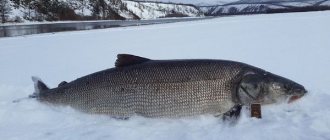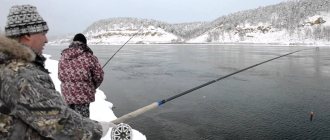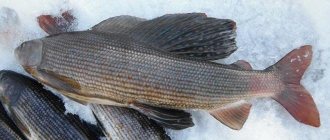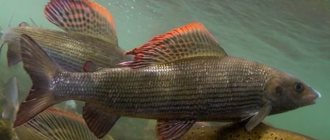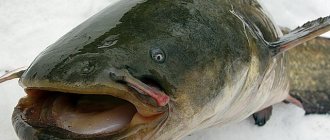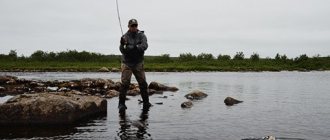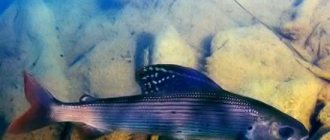Grayling fishing in winter is often characterized as difficult and unpromising. This northern inhabitant of the salmon family is not found everywhere (usually Siberia, Komi), preferring large rivers with fast currents and cold water. It is valued for its high taste. The average weight of a predator is about 1 kg, but larger specimens can be found - up to 3 kg. For winter fishing for grayling to be both exciting and productive, you need to know where to look, how it behaves during this period, and what it is caught with.
Behavior and activity of winter grayling
Like other underwater inhabitants, grayling significantly changes its behavior in winter. At the beginning of ice formation, the predator is in shallow water, chasing its prey. As ice thickness increases, it moves to deeper waters.
But in the midst of winter - the period of deep winter, grayling stays exclusively in deep areas where there is a strong stream, there are whirlpools, and a high concentration of oxygen in the water.
You shouldn’t count on a good catch in severe frost; the activity of the predator in extreme conditions is greatly reduced. Ice fishing for grayling in Siberia is much more successful at temperatures from -10...to -15 degrees. This river inhabitant does not belong to those fish species that are constantly in search of food.
Grayling prefers to stay at one point, waiting for the current to bring it food. Considering this point, when you pull out prey from one hole, you shouldn’t leave; there is a chance to catch several more.
Lure fishing
Spoons are not so popular when fishing for grayling in winter. But during the deep winter, when the fish stands almost motionless in deep holes, spinners show good results. Even very sluggish grayling respond well to small light-colored spoons, similar in appearance to real fish. The main shape is narrow-bodied and asymmetrical.
To increase the catchability of the bait, it is decorated with a bunch of hairs or threads. You can attach a bloodworm, a piece of worm, or a foam ball to the hook.
In this case, vertical trolling should take place at an average speed, the bait is raised by 25-30 cm, and short pauses must be made at the lowest point. When lowering the spoon, it is useful to make small twitches. If fishing takes place on fast-flowing rivers, then jig heads along with silicone baits are suitable.
Where to look for grayling in winter
Even a novice angler can catch grayling on the first and last ice. The main thing is to know promising places.
Small rivers
Catching grayling from ice on small rivers is only possible if it is known for certain that it has remained there for the winter. As a rule, the predator survives frosts in wintering pits in large water areas.
On small rivers it can be found in the same places as on open water. These are rapids, rifts. There are situations when fish live in clean pools with moderate currents. For the Siberian predator, it is preferable to stay in areas with a sandy or rocky bottom; it avoids silty areas. It would be more correct to mark work points since the summer, if the reservoir is familiar. On unfamiliar rivers, catching grayling is a matter of chance.
Big rivers
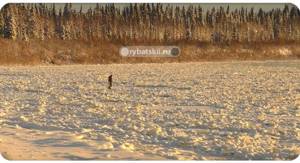
It is often possible to catch a predator on large and medium-sized rivers far from a powerful stream. It is worth working on stretches behind rifts, pebble and gravel banks. In such areas, by the end of winter, the water level under the ice is often up to 10 cm. Some of the catchable places remain:
- river/stream mouths;
- dumps;
- depth changes;
- boundaries of deep gullies and non-freezing rifts.
The more accurately the angler knows where the wintering pits of grayling are located, the greater the chances of getting good results. The predator almost never leaves them, feeding only next to them.
Lakes
Grayling fishing on the lake in December, as in January - February, will be quite successful. There is enough oxygen in the reservoirs, fish activity does not decrease at all, and you can hunt for almost the entire cold season. Promising places include:
- the upper edges of the pits;
- mouths of flowing rivers/streams;
- rocky shallows among serious depths;
- coastal zone with springs gushing at the bottom;
- sandy/rocky shallows, where the depth is up to 1.5-2 m.
If the weather is cloudy and gloomy, then you can plan your fishing for the whole day. A stable bite is observed only in the first two weeks of winter, then it is better to go out to the reservoir in the morning and evening. Winter fishing for grayling at night is also possible, especially on Lake Baikal. The predator bites mainly on moonless nights.
Fishing place

Finding fish under the ice is always difficult, but grayling is doubly difficult - in its habitats in winter the thickness of the ice cover reaches 1-1.5 meters. It should be remembered that it is useless to look for grayling in dirty water.
In winter it can be found in the following places:
• pools with a clean bottom made of pebbles, sand or stone; • reaches; • next to large stones; • exits and entrances from pits; • non-freezing river rapids near the ice edge; • differences in depths and slopes; • sections of the river next to a strong current; • mouths of tributaries flowing into a reservoir.
The colder it gets, the deeper the holes the grayling go into. In the wilderness, it can only be found in large, deep rivers and lakes, where it flows from small tributaries.
The best option would be to visit the reservoir in the fall and take note of the grayling sites. At the beginning of winter, in the first weeks after the ice has formed, grayling remains in the same places and one can hope for a good bite. It can also be helpful to talk to local fishermen about fishing spots.
Winter tackle for grayling and fishing techniques
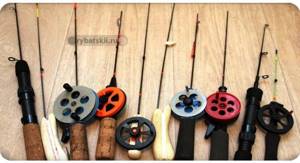
When choosing gear for catching grayling in winter, priority should be given to high-quality and durable tools. You can hunt with both a regular float rod and a manufactured winter donka. The main thing is to select several functional baits and follow the advice from experienced fishermen regarding the features of the game and setting the working height of the descent.
Fishing rod for ice fishing for grayling
Most often, cold water lovers are caught using jigs. Tackle for grayling for fishing in currents under ice is very similar to perch gear. They work on the predator using a simple balalaika. The suitable nods are rigid, powerful ones, made of lavsan, a nipple, or a clock spring.
The selection of fishing line is made taking into account the weight of the fish. For small individuals, a vein with a cross section of 0.12-0.14 mm is enough. To catch large specimens weighing over 1 kg, you will need a monofilament with a diameter of 0.18-0.20 mm.
How to catch grayling under the ice using jigs and flies
One of the most common methods of catching predators in winter is a jig. But you need to use it correctly, following the following recommendations:
- Choose tungsten products with a flat shape.
- Use jigs with stable play in the current.
- Strive to create a smooth, measured behavior of the jig in the water column. Only the realism of artificial bait will provoke the predator into active movements.
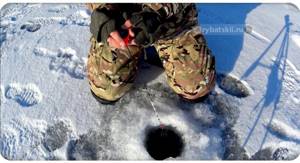
Taking into account the above points, the angler significantly increases the chances of catching winter lenok. The main thing here is to throw the jig sharply from the bottom by 15–30 cm. You should expect a response from the predator when it sinks smoothly to the starting point. This principle also works when using a jig in combination with live food, bloodworms.
When going ice fishing for a predator, it would be good to stock up on several catchable baits, different in weight and size. Silver jigs should be your priority. The shape is suitable in the form of a drop or a pellet. The hook is thin, size 3-6. To modernize the bait and make it more attractive to the eyes of fish, you need to tie a colored feather or a piece of nylon thread to the hook.
Most avid winter fishermen use a tandem of a jig and a fly for grayling. The result will be guaranteed when using insect-shaped flies, which are excellent for catching fish in open water. In the cold season, most often the predator reacts sharply to wet flies made on a hook with a short shank. They are knitted on the main vein, 15–25 cm away from the jig. You can add mormysh, or you can do without it.
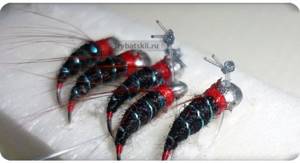
If hunting is carried out in an area with a depth of more than three meters, then to attract grayling it is better to use a garland of flies. They are mounted at intervals of 60 cm from each other. This makes it possible to examine all water horizons. There is an opinion that when fishing at impressive depths, it is better to use a regular lead weight installed at the end of the fishing line instead of a jig. Next they knit a garland of flies. In water, the game is similar to the previous version, the baits are sharply thrown 20–30 cm, and a bite is expected when they are lowered.
Grayling flashing from the ice
Using a spoon to catch a winter predator is almost always a win-win option, since in its natural environment it feeds on invertebrates, sometimes fry. Using a spinner is more effective on medium- and large-sized fish. This artificial bait is suitable for both bottom and vertical fishing, but in this case only with bait.
The equipment of a winter fishing rod for grayling for lure fishing is similar to that of a perch rod. They use small models 1.5-3 cm long, weighing from 3 to 8 g. To enhance the effect, animal food and a red tail are placed on the hook.

To attract a predator, use the following flashing technique:
- The spoon is sent to a specific horizon.
- Make a sharp swing with the fishing rod, lifting the bait to a height of 30 cm from the bottom surface.
- Return the rod to its original position, maintaining a short pause of 3–6 seconds, and repeat the manipulation.
- 6-7 such repetitions are enough for one hole. If there are no bites, then there is no need to waste time, but it is better to move on to the next one.
Thanks to this game, the predator quickly pays attention to the spoon, associating it with its usual food. But it is not possible to catch this method everywhere; it is more suitable for catching grayling on deep rivers of Siberia, such as the Lena and Yenisei.
Tackle with a lead and a fly
This tackle is distinguished by the presence of a hook with a nozzle and a weight that is not on the same line; they must be spaced apart. The weight is placed at the end of the vein; a leash with a hook and bait is mounted above. This technique is more relevant for catching fish near the bottom. There are different types of installation, including:
- Deaf. This is the easiest option to implement. The weight is tied at the end of the vein, a loop is formed above, retreating a distance of 20–30 cm. A leash with a hook is fixed to the resulting loop.
- A double swivel is attached above the installed load, then a leash. There is a way to install a triple swivel, where the line, leader and sinker are mounted to each hole of a separate swivel. Due to the use of swivels, the possibility of equipment overlap is eliminated.
- Sliding. A leash is fixed to the main vein, and a load is attached to the second leash, which moves freely along it. The optimal length of the leash is 20–30 cm. The leash is installed on a swivel located on the main conductor. At the end of the leash there is another swivel, to which the load is attached. The limiter is mounted at the point where the swivel is installed. Thanks to this approach, the angler has the opportunity to change the location of both the load and the leash. But there is one drawback: during casting, the cargo will fly first. To reduce slipping, you need to install another stop above the attachment point.

You can mount the leash to the equipment using one of the proposed options:
- Loop to loop. It is enough to make a loop at the end of the leash, then pass it through the loop formed on the fishing line. And insert a hook into this loop.
- Swivel mounting. This method allows you to reduce the frequency of overlaps.
- Mounting with fastener. The method is quite popular, with it you can easily change leashes.
Fishing for girders
The use of girders on a winter predator is completely justified. The only thing is that you need to use more delicate equipment than for pike. In principle, here you can get by with a simple fishing rod and a bright flag, which will be clearly visible from a long distance. Bait of animal origin is installed on it. Zherlitsa are excellent for catching low-active lenok.
Fishing with jigs
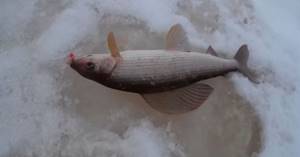
Quite often, grayling is caught from the ice using jigs. To do this, select heavy baits weighing at least a gram. It is better if they are made of tungsten or lead - such jigs are equally well suited for fishing at depth and on rivers with strong currents. They use baited jigs, reelless jigs, and self-made jigs.
Mothless.
If fishing is done with a baitless jig, then for grayling it is better to choose a golden-colored bait.
A simple but effective technique of the game is as follows: the bait drops to the bottom, followed by a sharp swing of 10-15 cm and a smooth descent back.
Jig with bait.
Fishermen often use additional animal bait along with a jig:
– bloodworms; – maggot; – burdock moth larvae; – worm; - mormysha.
There is a basic rule here - the bait should be the kind that grayling can find in its native reservoir. Otherwise, he will not react to the bait in any way.
White maggots that look too pale are given a bright color by dyeing them with beet juice. And cooking in well-salted water gives mormysh additional attractiveness.
Jig colors: golden, copper, lead.
Above the jig at a distance of 15-20 cm, you can tie an additional hook with bait. The length of the leash is 2-4 cm. An artificial fly is also suitable.
The game options are as follows:
- All layers of water from the ground to the lower edge of the ice are examined. The movements are smooth, with swaying from side to side with a radius of 1 cm. When biting a grayling, you might think that the hook is caught on something.
- After the jig touches the bottom, there follows a smooth, leisurely rise to a height of 5-8 cm. After this, the tackle is reset to its previous position and the bait begins to glide in the water. After a pause, the cycle repeats. At the lowest point, a bite usually occurs.
Homemade baits.

Many fishermen prefer to make their own baits. Making bait for catching grayling in winter is not as difficult as it might seem at first glance. As an example, you can take one of the options:
- Take a “pellet” or “droplet” jig, which has a thin hook with a long shank. You will also need a small colored feather. It is applied to the shank of the hook and tied with a thin nylon thread. The ends that stick out too much to the sides are cut off. The end result should be an imitation of an insect. To fully check, you should immerse the bait at home in water and see how it looks in it.
- Instead of a jig, you can take a regular long and thin hook, and replace the feather with fur or multi-colored threads. The main colors are brown and red.
- In Siberia, fishermen use fly agarics. To do this, take a regular hook and bend it to give the required shape (depending on the desire of the fisherman). An oblong, spherical or teardrop-shaped soldering is made on the forend. Next, the “fly agaric” is painted in the desired color and wrapped with horsehair, feathers or nylon threads to make it more similar to an insect larva. The edge is short. The colors for different types of grayling are different: for Siberian – dark (brown, gray), for European – bright (red, yellow).
The technique of fishing with such baits is no different from fishing with purchased jigs.
What does grayling catch and bite in winter?
In extreme conditions, both natural baits and artificial ones - balancers - are excellent for fishing. The first group includes all varieties of invertebrates, and the second group includes their imitation made of rubber and silicone.
Bloodworm
This is an excellent bait for large grayling. It is quite affordable and can be purchased at any specialized retail outlet. Bait consisting of two or three bloodworms is especially attractive to predators. In the depths of winter, only one fish can be caught. Most often, bloodworms are used with hook and jig tackle.
Small insects

Grayling feeds on fresh insects and readily responds to them. The main thing is to use the most realistic bait possible. The predator likes to feast on jigs and wormwood moth larvae. The first one is easy to find in burdock seed pods. The latter are located in the thickenings of Chernobyl stems.
Another effective bait option is caddisfly. It is prepared in the fall. In winter, it can be collected in an unfrozen reservoir among plant debris located at the bottom.
Worm and maggot
Worms are also harvested in the fall. To store them, it is better to choose boxes that are placed in any cool place, such as a cellar. In terms of catchability, worms are in no way inferior to bloodworms. There are situations when, with active biting, the fish reacts better to them. This natural bait is quite large in size and has a strong smell. Maggots, due to their external resemblance to small bark beetle larvae, are also a priority for the predator.
Other attachments
The spruce, pine or birch bark beetle is especially popular with fish in winter. Fishermen prepare bait in the fall, checking stumps for the presence of larvae in them. The bark beetle is also found on living trees, where it hides under exfoliated bark.
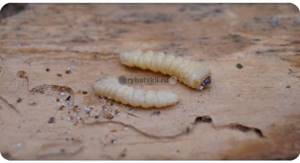
It is better to store bait in containers with sawdust in a cool room. With the onset of frost, the bark beetle falls into torpor and is not afraid of low temperatures. It is also possible to store it in the freezer. In winter, such bait instantly attracts the Siberian predator.
Fishing technique and time

The best time to catch grayling in winter is evening and morning hours. In the evening, fish should be looked for in holes and pools, and in the morning - on the rifts. Before sunrise the bite is most active.
On a cloudy day, grayling can actively peck throughout the day. Also, the number of bites increases during the thaw period, 3 days after the air temperature rises.
When fishing, you should drill a sufficiently large number of holes to increase the chances of finding fish. When fishing for grayling, even a half-meter distance can play a decisive role.
If a pool is found, this does not mean that there are grayling in it. To do this, you should make 2 holes at the entrance and exit of the pool and 3 more in the middle. The distance between them is 0.3 meters or more. You should fish each hole, starting from the first, spending no more than 10 minutes on each hole. If there are no bites, you should look for another place; if there are few bites, return here in the afternoon.
How and what to feed
Considering that the predator practically does not migrate long distances in winter, only during the period of a long thaw, feeding it is ineffective. The use of live bait in small quantities will be justified only when fishing in pits and pools. The components used here for fishing are used - worms, maggots, jigs, and bark beetle larvae.
It wouldn’t hurt to use grainy cottage cheese to feed grayling off the ice. The fish will immediately react to the characteristic smell and taste of this product. To deliver the cottage cheese to the fishing point, you will need a bottom feeder. Place a white foam ball on the hook.
In order to always have a catch in winter, it is recommended to use as bait those organisms that are found in a particular body of water. Grayling does not belong to the category of curious fish; it reacts only to living creatures that are familiar to it.
Fly fishing
In winter, grayling can be caught using a summer bait such as an artificial fly. It completely imitates real insects, which, of course, are not found in the cold season, but the fish quite willingly bites on such bait. When fishing with a fly, it is usually used as a second bait, clinging on a short leash slightly above the jig. The jig can also be replaced with a simple weight of appropriate weight attached to the end of the main fishing line. This type of equipment is called a “garland”. Hooks on flies should be small, and colors should be selected according to the same principle as for jigs - depending on the variety of grayling.
Weather influence and seasonality

Before going out hunting, you should familiarize yourself with the forecast for the grayling bite in winter. Although the fish is not highly dependent on weather conditions, knowing its behavioral characteristics at different periods of the season can significantly increase the chances of catching.
First ice
At the beginning of ice formation on small rivers, the predator shows increased caution; it can easily be scared off by excessive fuss. It is worth planning a hunt in clear weather in the morning. At lunchtime, it is also possible to go to a pond, but you need to choose an area with shade from the shore. It is not recommended to remove sludge from the hole. There are fishermen who, in order to create shade, lie down on the ice and cover themselves with a blanket.
If fishing takes place in large reservoirs on first ice, then it is worth fishing in the coastal zone, where it is cleaner and calmer. This is due to the formation of noise from slush flowing along the main channel.
Catching a predator on small rivers is quite difficult due to their accessibility. On a strong stream, ice has not yet formed, and in order to reach the operating points, you will have to make a lot of effort. Approaches are made from the shore.
Glukhozimye
Hunting for a Siberian predator in the depths of winter is characterized as quite dynamic. We have to look for fish. She is in wintering pits and does not leave them anywhere. The smallest baits will be required; the equipment should be as delicate as possible. A similar approach is needed when fishing in large bodies of water. The predator does not migrate anywhere, but continues to feed.
End of winter
Closer to warming - spring, working on the lower horizons is ineffective. In March, the predator is in the upper layers of the reservoir, where there is a high concentration of oxygen and is much cleaner.

When the ice breaks, a flood comes, the middle and lower currents become very aggressive, it contains slush, ice floes, and dirty water. From large rivers, fish are sent to small, flowing rivers. This is where you should try your luck.
Important things to know when fishing for grayling
In difficult fishing conditions, when you have to deal with strong winds, you need to use the same light tackle to choose places with calm or tailwinds. It is better to wait out severe bad weather altogether. If conditions require very long casts, then it is worth finding points (from the shore or wade) from which you can reach the fish. If possible, use a raft or boat. Replacing light tackle in difficult conditions with coarser and larger class is the wrong decision. In addition to the loss of sensation and pleasure from the process of catching and playing, you will inevitably reduce the number of bites. Larger line is more visible, splashes louder on the water, and you will not be able to use a very thin leader and very small flies. In addition, the number of landings, especially of small and medium-sized fish, will increase sharply. A 6th class rod, for example, will not provide ideal shock absorption when playing fish weighing 200 grams. But we want to enjoy catching each of our trophies, don’t we?

What to catch grayling in February
The best choice for February grayling is a regular winter fishing rod with a nod and a jig. If you use a jig or fly, then be prepared for an active fishing style. With a good bite, grayling attacks the bait sharply, and its bite is clearly felt through the rod. Even small fish of this species can break a line of 0.10-0.12 mm. It’s better to play it safe and install an inconspicuous fishing line of 0.18-0.20 mm on the fishing rod.
What do grayling bite on in February?
Winter bait for grayling can be divided into two types: animal baits and artificial baits. Each of them has its own advantages.
Baits for grayling in February
List of catchable baits for catching grayling in February:
• Dung worm is one of the most popular and traditional baits. Now that this bait has begun to be sold in fishing stores, it has become easier to get it, even for residents of big cities. Often in villages, cowshed owners also sell, and sometimes even give away the worm for free. The dung worm is a fairly large and mobile bait, which is why it attracts the attention of passive grayling in February;
• Bloodworms are also quite popular. You can buy it at any fishing store. It is attached to the hook in a bunch. To prevent the bait from leaking out, bunches of bloodworms should be prepared in advance, and when fishing, they should be tied under the throat of the hook or secured with an elastic band;
• Bark beetle is an ideal choice for February grayling. But getting it in winter is not easy, because unlike other baits, it is not sold in stores. Experienced fishermen begin stocking up on bark beetles in the fall: gutting rotten stumps, tearing off bark from rotten trees. This larva is stored in a box with sawdust, and when it hibernates, it tolerates the cold well. Experience shows that the bark beetle accounts for the largest catch of grayling in February. An alternative replacement for bark beetle is maggot;
• We can also use a number of other catchable baits. These include mormysh, wormwood and burdock moth larvae. The caddisfly larva should be highlighted separately. The only drawback is the difficulty of extraction and storage in winter;
• To catch large grayling, live bait fishing is used. It is better to use small fish caught in the grayling habitat as live bait.
Lures for grayling in February
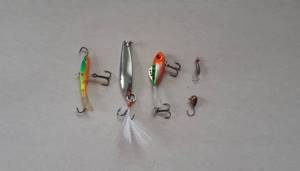
• The fly is a classic bait for summer fishing. But doesn't it become useless in winter, with insects hibernating? Surprisingly, if you tie the fly on a separate leash, the grayling bites on it no worse than in the summer. Particularly effective are the so-called nymphs, which imitate arthropod insects. Fly fishing often results in a good catch;
• Jigs. Various jigs for grayling with bait and baitless models are used;
• Grayling typically feed on bottom-dwelling larvae, insects and crustaceans. But it should be borne in mind that large individuals are typical predators and do not miss the opportunity to feast on small fish. If there is a possibility of catching a large grayling, then small ratlins, oscillating spinners for vertical trolling and fishing balancers up to 5 cm long can be used as bait.
Grayling fishing in February has its own characteristics. The behavior of the fish and its habitat are changing. When fishing for grayling from ice, you have to constantly experiment with the composition of the bait, lures and baits. These tips will help you leave the pond with a good catch.
